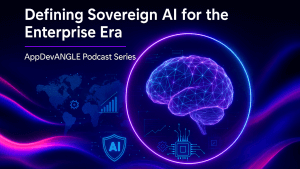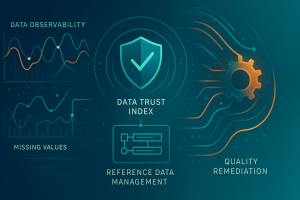The sovereign AI infrastructure opportunity (i.e., AI built so enterprises and nations retain full control over their data stack) is estimated at $1.5 trillion globally, with roughly $120 billion in Europe alone. In this episode of AppDevANGLE, I spoke with Sudeep Goswami, CEO of Traffic Labs, about what “true sovereignty” actually means, why cloud-agnostic and offline deployments are becoming non-negotiable, and how NVIDIA NIM–powered safety pipelines and an MCP gateway can enforce governance for human and non-human identities across environments.
What Sovereignty Really Means (And What It Doesn’t)
We started by pinning down the word that everyone uses but few define precisely.
“For us, sovereignty has three lenses,” Sudeep told me. “Architectural control, operational independence, and escape velocity.”
He broke it down:
- Architectural control — “Run your entire AI stack—gateways, models, safety, governance—in your own environment: your data center, a sovereign cloud, even air-gapped. No required connections to external services or dependencies on a vendor’s uptime or terms.”
- Operational independence — “Your policies, security controls, and audit trails must travel with the workload wherever it runs.”
- Escape velocity — “No lock-in to proprietary APIs, formats, or deployment patterns. If you need to leave a provider, it shouldn’t be prohibitively expensive or technically blocked.”
Sudeep also flagged three common misconceptions:
“Data residency is not sovereignty. If your control plane lives elsewhere, you’re not sovereign. Hybrid cloud is not sovereignty. If core functions still depend on a cloud, you’re not sovereign. Vendor-managed sovereignty isn’t sovereignty. If you operate on their terms, they can change the rules.”
Offline, Multi-Layer Safety Pipelines (NVIDIA NIM Inside)
Safety can’t be an afterthought, and it can’t depend on someone else’s network.
“Traditional safety calls out to a cloud moderation API before or after an LLM call,” Sudeep explained. “That adds latency, creates a single point of failure, and is a non-starter for air-gapped deployments. Even metadata leakage, signaling that a sensitive query occurred, becomes a vulnerability.”
Traffic’s approach, built with NVIDIA NIM, runs fully offline:
- Topic control — “Enforce allowed domains (e.g., finance-only) so prompts don’t drift.”
- Content safety — “Detect PII, toxic content, and policy violations in-situ.”
- Jailbreak detection — “Catch adversarial prompts (‘developer mode,’ prompt-injection tricks) locally.”
“All of this runs in your data center or sovereign cloud, with local GPUs and local models,” he said. “No external dependency, and no metadata exhaust escaping your perimeter.”
Governing Agent Access With an MCP Gateway
The risk model changes when agents can act, not just answer.
“Until now, AI was Q&A,” Sudeep said. “With agentic AI and MCP servers/agents, AI can read databases, call internal APIs, file tickets, send emails, execute code. You need a governance layer for that, and most enterprises don’t have one yet.”
His prescription: “Every agent gets its own identity. Bind policies to that identity. Enforce them at the gateway layer for a complete, objective view of what’s happening.”
That’s the role of Traffic’s MCP gateway: identity-aware mediation of agent actions across databases, APIs, and critical systems under the same policy fabric, no matter where the workload runs.
Cloud-Agnostic and Offline: The New Flexibility
I asked how customers are using portability to balance innovation and compliance.
“We’re at an inflection point,” Sudeep told me. “Customers are moving from ‘Can I deploy AI?’ to ‘Can I control AI?’ Many want location- and deployment-agnostic options, even if not mandated yet. Defense, intelligence, parts of healthcare and finance are already there.”
Traffic’s stack (AI gateway, MCP gateway, safety pipelines, agent governance, observability) was “architected from the ground up” to run with zero external dependencies and travel with you:
“Start in Oracle Cloud; later move to an air-gapped site or on-prem. Policies and architecture come with you.”
How the Oracle Alignment Plays Into the Market
We talked about the Oracle partnership and where it fits versus hyperscalers.
Sudeep outlined three segments:
- Cloud-native only — Startups/digital natives “all-in” on hyperscalers for managed services and minimal ops.
- Cloud-first, sovereignty-aware — Large enterprises that want cloud agility and the option to relocate workloads as regulations or geopolitics shift. “This is where most of the leverage is.”
- Sovereignty from day one — Defense, intelligence, and regulated sub-sectors that must run sovereign/air-gapped now.
“For segment 2 and 3, Oracle plus Traffic offers a portable sovereign AI architecture,” he said. “For segment 1, staying on AWS/Azure/GCP may be fine until sovereignty pressures emerge.”
Path to Adoption
- Define sovereignty upfront: Write down architectural control, operational independence, escape velocity as requirements.
- Uncouple safety from the cloud: Run topic control, content safety, jailbreak detection offline to eliminate network dependency and metadata leakage.
- Give agents identities: Treat non-human identities as first-class citizens; bind least-privilege policies; enforce at the gateway.
- Make governance portable: Package policies, audit trails, and controls so they travel with workloads across clouds, on-prem, and air-gapped.
- Instrument for proof: Log every action (human and agent), maintain tamper-evident audit, and map controls to regulatory frameworks.
- Plan the exit: Avoid proprietary APIs/formats. Test cloud-to-on-prem and on-prem-to-air-gap moves before you need them.
Analyst Take
Sovereign AI is quickly moving from boardroom talking point to architectural mandate. The signal from this conversation is clear: sovereignty isn’t a hosting location; it’s a design principle with three measurable properties:
- Architectural control — You can run everything locally (models, safety, governance) with no external dependencies.
- Operational independence — Policies, security controls, and audit trails move with the workload across environments.
- Escape velocity — You can leave any provider without breaking your stack or rewriting to proprietary interfaces.
Enterprises that equate data residency with sovereignty will get surprised by control-plane drift, metadata leakage, and safety API single points of failure. The corrective pattern is offline, multi-layer safety (topic control → content safety → jailbreak detection) and an identity-aware MCP gateway that governs agents like employees—unique identities, least-privilege scopes, and auditable action logs.
Strategically, the market will bifurcate:
- Cloud-native teams will stay put until regulations, M&A, or geopolitics force workload portability.
- Sovereignty-aware and sovereignty-mandated sectors will standardize on cloud-agnostic, offline-capable stacks that can prove control, not just claim it.
My guidance is to treat governance as code and policy as a portable artifact. Decouple safety from the internet, put non-human identities under the same IAM rigor as humans, and test your exits before you need them. Do this, and you’ll be positioned to exploit multi-cloud economics and edge/air-gap deployment models without compromising trust, compliance, or control.



